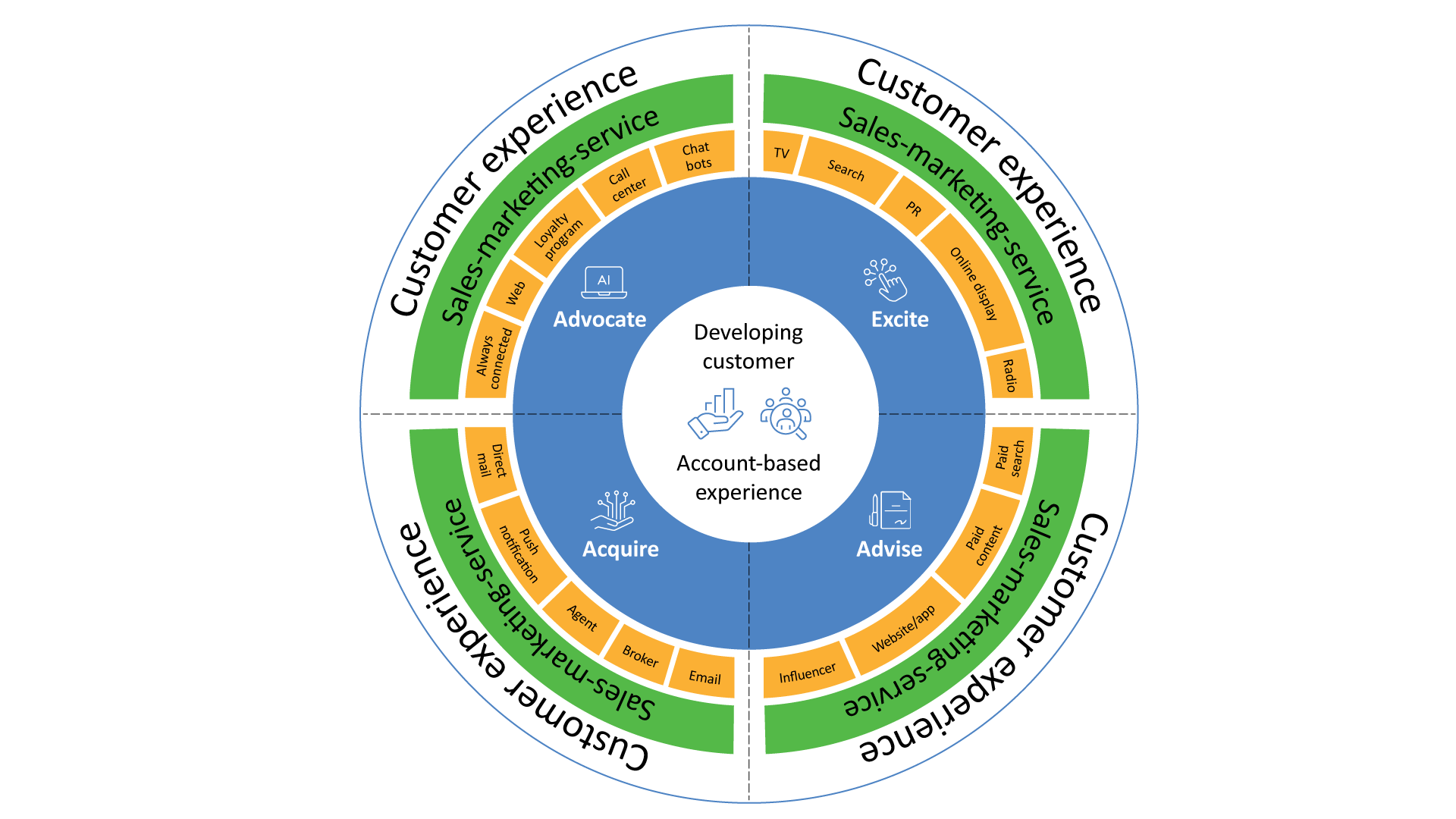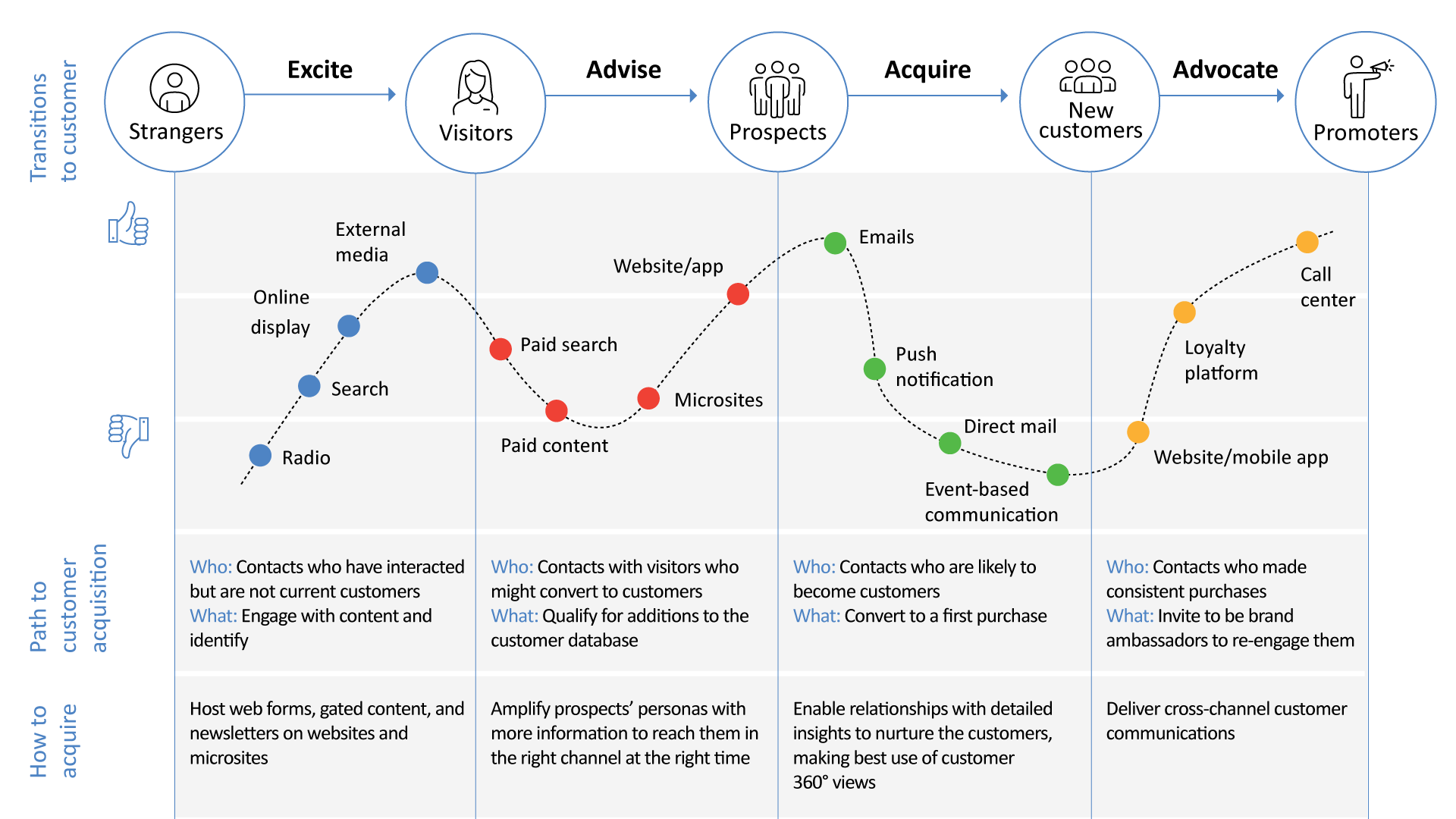Service
Highlights
- Digital technologies have changed customer interactions and expectations, forcing enterprises to rethink how they connect with customers. It’s time to rethink account-based marketing (ABM).
- Account-based experience (ABX) represents a new paradigm for traditional ABM, which is mostly governed by the long-standing funnel-based sales and marketing process.
- ABX is a B2B strategy where sales, marketing, and customer success teams collaborate to select high-value accounts and develop unique, personalized experiences that cover the full customer journey.
- A wheel-based approach to ABX lets B2B enterprises continue using funnel-based ABM as they shift to a more dynamic, adaptive model.
On this page
Customers want more
The business-to-business (B2B) market has changed considerably, and organizations cannot afford to operate the same way they have been doing for decades.
Customers are tech-savvy and digital disruption has changed product and service discovery as well as customer perceptions, interactions, and most importantly, expectations. The old ways of connecting with customers are no longer effective.
With all of this in mind, enterprises should ask themselves if they can afford the status quo of a multi-stage sales and marketing funnel to acquire a new customer. With information readily available and the customer well-informed, are we still thinking that customers only want products and services, or are they looking for more?
Customers certainly are looking for omnichannel experiences that engage and thrill them. So, why are B2B enterprises limiting themselves to traditional account-based marketing (ABM)?
Challenge tradition
Account-based experience (ABX) is a modern approach to conventional loyalty programs.
ABX is a B2B strategy where, during the customer journey, sales, marketing, and customer success teams join forces to select high-value accounts and develop unique, personalized experiences in each of these areas. As opposed to all accounts, ABX focuses primarily on key high-value accounts. ABX represents a new paradigm for traditional ABM, which is mostly governed by the long-standing funnel-based sales and marketing process and can require as many 8-14 steps to complete, depending on the complexity of the customer landscape. However, because B2B customers now expect to be treated like B2C customers, enterprises are required to provide customers with a B2C sales experience and must participate in a short selling cycle.
Companies are beginning to adopt the concept of ABX where B2B and B2C marketing strategies overlap in a short sales cycle to attract, assist, acquire, or promote their customers. Research from Market Resource Partners illustrates how digitalization is shifting marketing strategies: about one-quarter (27.5%) of marketers say they have significantly changed the channels they use to reach targets. Another 20% say that targets are not as responsive to the same kinds of content they have been delivering.
Overcome obstacles
Today's customer interactions are broader than before.
This requires companies to focus not only on channel interaction but also on delivering a consistent customer experience across all touchpoints along the buying journey. But the truth is that enterprises in the B2B space are struggling with challenges such as siloed customer experience, long sales cycle, and disconnected operations between sales, marketing, and service organization.
ABX can be a vital tool in addressing these challenges.
A wheel-based approach to ABX can help address the core challenges of B2B enterprises while also allowing them to continue using funnel-based ABM during the transition from one to the other. Integral to the approach is a shift from customer to developing customer, and enabling an easy transition of leads to customers.
Wheel-based ABX transforms the customer's journey by replacing the traditional linear funnel with a dynamic, adaptive model. In this context, the customer journey becomes a personalized and continuous experience. Accountants no longer follow a predetermined path; instead, they enter a central hub where their unique needs and behaviors guide their journey. The approach leverages data analytics and automation to provide a comprehensive view of accounts, enabling marketers to deliver precisely tailored content and interactions at every touchpoint. Wheel-based ABX recognizes that the customer journey is dynamic, and allows accounts to enter, exit, and re-engage as requirements evolve, resulting in deeper, more lasting relationships between businesses and their most valued prospects.
Wheel-based ABX emphasizes real-time personalization and adaptability. This innovative approach ensures that each account's journey is unique and continuously optimized, leading to stronger connections and improved outcomes in today's ever-changing business landscape.
Customer ownership data, often referred to as first-party data, is an essential part of the success recipe for ABX deployment. It forms the basis of data-driven insights powered by dynamic algorithms for ABX. These algorithms assign weights based on successful conversions associated with specific touchpoints. This allows businesses with lean customer journeys to focus on transitions and do a better job of acquiring leads and customers at all touchpoints using high credit scores. These scores, which are the scores of customers who are likely to convert into buyers, are comparable to credit scores mortgage companies use to determine which home buyers will fulfill their loan obligations.
Drive engagement
Explore customer engagement through the ABX lens.
- Start with excite.
The most difficult thing on the customer journey is to get strangers who have had no interaction with your business, product, or service to get interested in what you have to offer. To lure and attract them with ABX, enterprises can apply the following method:
- Get: As the ABX theme suggests, target high-value customers and focus on those prospects who have interacted with the brand but are not current customers.
- To: Engage the stranger with the brand; focus on identifying the contact and building a persona around contact capturing, motivation, ability, and trigger.
- By: Capture contact details via web forms, paid media, and webinars.
- How: Hosting web forms, gated content, etc., on websites and microsites.
- Advise contacts.
Advising a prospective customer with the right amount of information on the right channel at the right time is vital to building a long-term relationship with the customer. ABX's focus is on the delivery of very personalized customer communication through different channels to ensure that they are coherent and highly contextualized, in line with customers' needs. This can be achieved through the following:
- Get: Contacts that are identified as visitors have a medium propensity to convert into customers. Focus on frequent visitors with precise customer personas and also visitors who have engaged with product pages.
- To: Qualify them as prospects or marketing-qualified leads and start delivering marketing communications with relevant information in the current context.
- By: Activate targeted content via ads to get traffic to the company website and deliver personalized landing pages and targeted content for better conversation.
- How: Build insights based on customer interactions to trigger communications. Amplify your persona with more information to reach prospects at the right channel and at the right time.
- Acquire the customer and get the first purchase done.
At this stage, sales play an important role in acquiring customers. As stated earlier, through ABX, the idea is to target high-value customers and that is followed at this stage too, where the focus is on micro-segmentation with the right customer acquisition strategy. Sales can follow these practices:
- Get: Contacts with a high propensity to convert into customers are targeted at this stage with highly personalized communication. This is possible by having seamless coloration between sales and marketing. Sales have 360-degree views of customer interactions and responses, which helps channel better interaction with the customer.
- To: Sales have only one target at this stage, to get the first purchase with the customer through. ABX strategy dynamic algorithms will help sales managers evaluate paths with conversions and those without conversions.
- By: Trigger sales activation through trigger-based communication. Real-time communication in the current context is important at this stage. Seamless collaboration between customer relationship management (CRM) and customer data platform (CDP) systems will allow sales managers to be on top of their game.
- How: Enable long-term relationships by furnishing sales managers with detailed insights that can facilitate trust with the customer.
- Advocate with a customer-first approach
At this stage, focus on customer engagement and keep their excitement quotient high. Use ABX to serve customers with relevant information but steer clear of information overload and communication fatigue. Bring sales, marketing, and service together and drive customer engagement with a customer-first approach emphasizing on the following:
- Get: Focus on customers who have already made their first purchase. Devise a program to re-engage and start fresh for a new product cycle based on the customer persona relevancy. With ABX, build an engagement roadmap for the customer to build an ideal customer profile.
- To: Carve out a loyalty program for customers based on purchase cycle, industry, and requirements. Give them a motive and trigger for continuous engagement.
- By: Make customers feel special by triggering customer surveys, special invitations to an event, and workshops, and building public personas for them.
- How: Deliver cross-channel customer communications to stay on top of customer needs and expectations.
ABX represents a paradigm shift in marketing, introducing innovative practices that diverge from the conventional funnel-based approach. It places a premium on personalization and the precise targeting of accounts, fostering enriched relationships and reshaping the customer journey. This forward-looking strategy is essential for adapting to evolving market dynamics and staying at the forefront of customer engagement.


